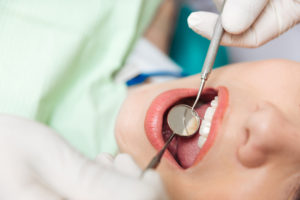Many adults in America suffer from periodontal disease, also known as gum disease. Gum disease can have a wide variety of symptoms that range from mild inflammation to extreme tissue damage that results in lost teeth. You might know that gingivitis is one of the more common types of gum disease, but what exactly causes it, and what are its symptoms?
We’ve outlined below the different causes and symptoms of gum disease so you can further understand how to prevent this condition or catch it in the early stages. If you have any more questions about spotting gum disease, contact your dental care provider — and consider finding a dentist who uses DentalVibe.
What is gingivitis?
Gingivitis is an early form of gum disease that can cause gum redness, swelling, and bleeding. Most often, gingivitis occurs due to poor oral hygiene, which leads to plaque and tartar buildup. When gingivitis is caught early, professional treatment can reverse the condition.
If left untreated, gingivitis can cause tissue damage, jaw bone damage, gaps between teeth, and a variety of other concerns. Gingivitis is serious and should be treated promptly. It can lead to a more serious gum disease called periodontitis, which can cause tooth loss.
What causes gingivitis?
The most common cause of gingivitis is the accumulation of bacterial plaque between and around the teeth. Our mouths are loaded with bacteria, which in turn forms plaque on the teeth. If you don’t properly brush and floss, this plaque calcifies over time and becomes tartar. Plaque and tartar irritate the gums, causing inflammation.
In most cases, the development of plaque is inevitable, but there are certain risk factors that expedite its production:
Smoking
One of the worst things you can do for your oral health is developing a smoking habit. Smoking damages the body’s blood vessels, which slows the healing process of damaged gums. Smoking also suppresses the immune system, which greatly reduces its ability to fight off the early signs of infection.
Prescription medications
Many prescription medications impair the production and flow of saliva throughout your mouth. Saliva plays a necessary role in breaking down plaque and keeping the mouth clean. Certain medications can also cause unnatural gum overgrowth, which requires medication or surgery.
Genetic predisposition
Not all risk factors are within your control. While you can take preventive measures to significantly lessen your risk of developing gum disease, you may still be susceptible due to your family history.
Changes in hormones due to pregnancy, puberty, menopause, and other events may lead to more sensitive gums that are prone to inflammation. Some diseases such as cancer, diabetes, and HIV also increase the risk of gingivitis. Poor diet and advanced age can also increase your risk of developing these oral conditions.
Gingivitis symptoms
Tender gums and inflammation
Inflamed, bleeding, and sensitive gums are the most common signs of gingivitis. Gums may also be tender and sometimes painful to the touch. They can also appear puffy and might be softer than normal. This is due to the inflammation caused by the buildup of tartar and plaque on your teeth. The early symptoms of gingivitis are not wholly consistent and differ from person to person, which is why in the early stages, it’s difficult to determine whether you have the disease. Plus, over-brushing or flossing can cause similar symptoms, leading patients to believe that they simply have sensitive gums, rather than inflamed gums.
You might fear bringing up symptoms of gingivitis with your dentist because you don’t want to be criticized for the state of your oral care. But good dental providers know that it isn’t fair or productive to judge their patients’ dental habits. If your dentist notices the early stages of what could be gingivitis, they will recommend the best techniques for brushing and flossing. If it’s minor enough, gingivitis is often cured through good brushing and flossing, and perhaps an antibacterial mouthwash, to ensure the bad bacteria is eliminated.
Halitosis
Halitosis, or bad breath, is another subtle sign of gingivitis. Like tender gums, halitosis can be caused by a number of things, including chronic conditions, spicy foods, or smoking — or it could simply be a case of morning breath.
To be sure that you don’t have gingivitis, it’s best to be thorough and pay attention to any other signs happening in conjunction with halitosis. As with tender gums, your dentist can recommend oral care tips, such as avoiding alcohol-based mouth rinses and remaining hydrated. Ideally, though, you will want to have your mouth examined by your dentist to be absolutely sure it isn’t a simple case of bad breath.
Bleeding and discoloration
When gingivitis is at its worst, gums change from their healthy pink to a bright red or purple. They will also bleed when you brush or floss. At this stage, you will most likely need to see your dentist about scaling, or removing the buildup of plaque and tartar, and perhaps fixing other issues that are contributing to the inflammation. For example, if you have a few cavities or an improperly installed bridge or crown from a previous dentist, it could play a role in your oral health.
What is periodontitis?
Periodontitis is a more severe form of gum disease. This occurs when gingivitis has advanced, leading to an inflammatory response that destroys bone and tissues. Periodontitis causes the gums to separate from the teeth, creating spaces and pockets in between teeth, which trap bacteria and lead to infection. Your body’s natural response is to fight the infection, and when it does, you’re seemingly worsening your condition by breaking down the structural bone and tissue that hold your teeth. If this bone and tissue becomes too damaged, your teeth may become loose or fall out.
How does a periodontist treat gum disease?
Periodontal surgery is sometimes needed to treat gum diseases and conditions such as gingivitis and periodontitis. This type of surgery is commonly known as gum surgery and is typically performed by a periodontist, which is a type of doctor who specializes in treating the gums and the bone supporting the teeth.
A periodontist can use several types of gum surgery to treat different oral health concerns. The best type of surgery for you will depend on factors such as the type and severity of your gum disease. Before surgery, some dental surgeons may want to perform a deep clean of the teeth, roots, and gums. Deep cleaning procedures such as root planing or deep scaling of the teeth help remove tartar and bacteria and smooth the surfaces of the teeth or roots.
The following are some of the procedures that a periodontist may use to treat gum disease.
Flap surgery
This type of surgery is helpful for people who have tartar buildup in deep pockets in the gums. The gums are lifted off the teeth to allow for deep cleaning. Your doctor will use stitches to refit the gums in place. Bone reshaping may be needed in some cases.
Bone grafting
When the bone surrounding a tooth is compromised or destroyed, some patients need a bone graft to rebuild and restore the bone. Patient bone, donor bone, or manufactured bone can be used for bone grafting. Bone grafting holds the tooth in place and allows it to become more stable in the jawbone.
Guided tissue regeneration
In this procedure, mesh material is placed between the patient’s bone and gum tissue, preventing the gum from growing where bone should be, and allowing bone and accompanying connective tissue to form.
Tissue grafting
Tissue grafting may be used in cases of gum recession, which is a loss of gum tissue. During this procedure, a surgeon grafts tissue – often from the roof of the patient’s mouth – to the area where the gum has receded. This protects the area, reduces the risk of further damage, and covers exposed roots.
How long does periodontal surgery take?
Most periodontal surgery procedures take about two hours to complete. Many procedures require complete or partial sedation, and a few require only a local anesthetic. Following the surgery, patients will receive complete instructions for care and recovery.
Your dental provider can work with you to ensure a pain-free anxiety-free dental treatment. A variety of medications, processes, and technologies are available that can help you remain calm and comfortable during your procedure, and that will ensure you experience minimal pain.
Take control of your oral health
Gingivitis and periodontitis can often be prevented with good oral hygiene and regular dental visits, but if you find yourself needing treatment for these conditions, don’t let a fear of the dentist stand in your way.
Many dentists use advanced tools and techniques to ensure that dental procedures remain as comfortable and pain-free as possible. Ask your dentist or oral surgeon about DentalVibe, a tool that completely eliminates the pain of dental injections. If your oral health care provider doesn’t use DentalVibe, let them know you’re interested, or view our directory for a list of DentalVibe certified providers.
Take charge of your oral health. Don’t let problems become bigger problems. Conquer your dental concerns by partnering with a dentist who can help you manage your oral health and dental anxiety to ensure that you have a beautiful smile for years to come.
















